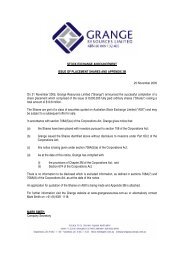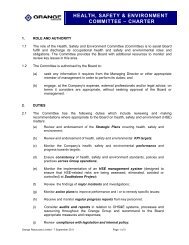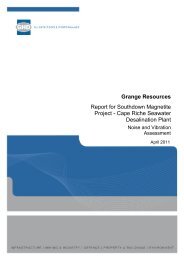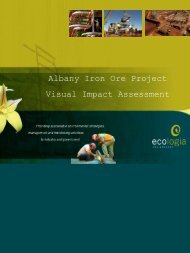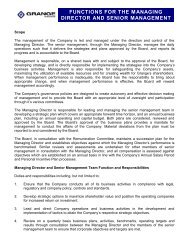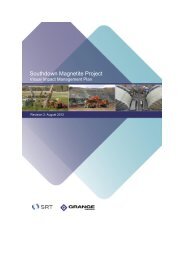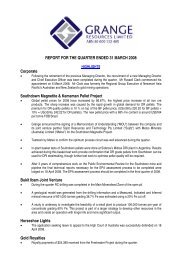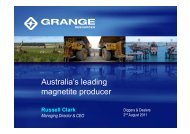2010 Annual Report - Grange Resources
2010 Annual Report - Grange Resources
2010 Annual Report - Grange Resources
Create successful ePaper yourself
Turn your PDF publications into a flip-book with our unique Google optimized e-Paper software.
DECEMBER <strong>2010</strong> ANNUAL REPORT 45<br />
(e) Business combinations (cont.)<br />
Deferred consideration is measured at the present value of<br />
management’s best estimate of expenditure required to settle the<br />
present obligation at the reporting date. The discount rate used<br />
to determine the present value reflects the current assessment<br />
of the Group’s incremental borrowing rate. The increase in the<br />
provision due to the passage of time or ‘unwinding’ of the<br />
discount is recognised as a finance expense. Other movements<br />
in deferred consideration, including those from updated short<br />
and long-term commodity prices and forward exchange rates are<br />
recognised in the income statement to the extent that they do<br />
not exceed the discount on acquisition initially recognised.<br />
(f) Revenue recognition<br />
Revenue is recognised and measured at the fair value of the<br />
consideration received or receivable. The Group recognises<br />
revenue when the amount of revenue can be reliably measured, it<br />
is probable that the economic benefits will flow to the Group and<br />
specific criteria have been met for each of the Group’s activities<br />
described below.<br />
Revenue is recognised for the major business transactions as<br />
follows:<br />
Sales of iron ore<br />
Revenues from the sales of iron ore are recognised when the<br />
significant risks and rewards of ownership of the goods have<br />
passed to the customer and the amount of revenue can be<br />
measured reliably. Risks and rewards are considered passed to<br />
the buyer at the time when title passes to the customer.<br />
The majority of the Group’s sales arrangements specify that title<br />
passes when the product is transferred to the vessel on which<br />
the product will be shipped. Revenues are generally recognised<br />
on the bill of lading date. Sales arrangements allow for an<br />
adjustment to the sales price based on a survey of the goods by<br />
the customer (an assay for mineral content). Accordingly, sales<br />
revenue is initially recognised on a provisional basis using the<br />
most recently determined estimate of the product specifications<br />
and subsequently adjusted, if necessary, based on a survey of<br />
the goods by the customer.<br />
The Group has agreed with customers to price its iron ore pellets<br />
at index based market prices. Interim pricing arrangements have<br />
been agreed with customers and will remain in place until such<br />
time as an index based market pricing mechanism is agreed.<br />
Accordingly, sales revenues have been initially recognised using<br />
interim prices and will be subsequently adjusted, if necessary,<br />
when an index based market price is agreed with customers.<br />
Royalties<br />
Royalty revenue is recognised on an accrual basis in accordance<br />
with the substance of the arrangements.<br />
Interest revenue<br />
Interest revenue is recognised on a time proportion basis using<br />
the effective interest method.<br />
Dividend revenue<br />
Dividends are recognised as revenue when the right to receive<br />
payment is established.<br />
(g) Government Grants<br />
Government grants are recognised when there is reasonable<br />
assurance that the grant will be received and all attaching<br />
conditions will be complied with.<br />
When the grant relates to an expense item, it is recognised as<br />
income over the periods necessary to match the grant on a<br />
systematic basis to the costs that it is intended to compensate.<br />
When the grant relates to an asset, the fair value is credited<br />
to a deferred income account and is released to the income<br />
statement over the expected useful life of the relevant asset by<br />
equal annual instalments.<br />
(h) Leases<br />
Leases are classified as either operating or finance leases at the<br />
inception of the leases based on the economic substance of their<br />
agreement so as to reflect the risks and rewards incidental to<br />
ownership.<br />
Finance leases, which are those leases that transfer substantially<br />
all of the risks and rewards incidental to ownership of the leased<br />
item to the Group, are capitalised at the present value of the<br />
minimum lease payments and disclosed as property, plant and<br />
equipment. A lease liability of equal value is also recognised.<br />
Each lease payment is allocated between the liability and<br />
financing costs. The finance cost is charged to the income<br />
statement over the lease period so as to produce a constant<br />
periodic rate of interest on the remaining balance of the liability<br />
over the period. The property, plant and equipment acquired<br />
under a finance lease is depreciated over the asset’s useful life or<br />
over the shorter of the asset’s useful life and the lease term if<br />
there is no reasonable certainty that the Group will obtain<br />
ownership at the end of the lease term.<br />
Operating leases are those leases that do not transfer a<br />
significant portion of the risks and rewards of ownership to the<br />
Group as lessee. Payments made under operating leases are<br />
charged to the income statement on a straight-line basis over<br />
the period of the lease.<br />
DirectorS’ <strong>Report</strong><br />
Financial Statements<br />
Shareholder information



